
Ear Trumpet Labs – Edwina Microphone Review
Sunday, March 25th, 2012 | by Don Gunn
It’s a rather unique and great time in which we live; in this internet-driven age, small- and sometimes even singularly-staffed manufacturers can craft products and market them to the world with nothing more than a website. No more having to only choose from a small handful of companies making products for the masses; there are now hundreds of options in every possible price range. While this amount of choice can lead to option overload and make it more difficult to separate the proverbial wheat from the chaff, there are many companies making excellent new tools for our craft.
Self-proclaimed “Bricoleur,” Philip Graham, started Ear Trumpet Labs as a way to place his Schoeps-style FET circuit into microphone bodies of his own design and imagination that recall everything from the spring-loaded shockmounts of early ribbons and condensers to industrial/”Steampunk” assemblages of discarded bicycle parts and copper tubing. They are as much works of art as they are functional instruments for audio.
ETL’s  Edwina ($499 direct from the company) is a large-diaphragm condenser sporting a 1-inch (26mm) capsule mounted between a pair of plumbing flanges; a two-layer mesh grille backed with silk provides an integral pop filter which works as advertised. I used the Edwina on a lead vocal with no additional pop filter on a notoriously spitty singer and had no plosive issues with him, even right up on the mic.
Edwina ($499 direct from the company) is a large-diaphragm condenser sporting a 1-inch (26mm) capsule mounted between a pair of plumbing flanges; a two-layer mesh grille backed with silk provides an integral pop filter which works as advertised. I used the Edwina on a lead vocal with no additional pop filter on a notoriously spitty singer and had no plosive issues with him, even right up on the mic.
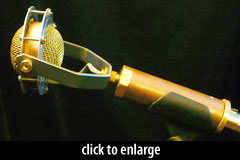 The capsule assembly is surrounded by a copper ring to which a pair of thumbscrews are bolted; these screws pass through the end of a steel yoke and this mounting method allows for the capsule to pivot for either side-address or front-address configurations (or anywhere in between). A beefy cable exits the bottom of the capsule ring and passes into the mic body via a threaded brass insert that also mounts the yoke to the body. The body is a 3-inch piece of substantial copper tubing that I’m sure will take on a lovely patina as the mic ages. A bronze end-cap holds the XLR connector and also has the mic’s serial number and “ETL” stamped onto its perimeter — there are no other logos/branding/icons on the mic body. The pair of mics that I tested (which are my personal pair, purchased a few months ago after first hearing of the company) shipped in individual fire-engine red, metal boxes with handles, dense foam cut-outs for the mics and egg-crate foam in the lids for some serious traveling protection.
The capsule assembly is surrounded by a copper ring to which a pair of thumbscrews are bolted; these screws pass through the end of a steel yoke and this mounting method allows for the capsule to pivot for either side-address or front-address configurations (or anywhere in between). A beefy cable exits the bottom of the capsule ring and passes into the mic body via a threaded brass insert that also mounts the yoke to the body. The body is a 3-inch piece of substantial copper tubing that I’m sure will take on a lovely patina as the mic ages. A bronze end-cap holds the XLR connector and also has the mic’s serial number and “ETL” stamped onto its perimeter — there are no other logos/branding/icons on the mic body. The pair of mics that I tested (which are my personal pair, purchased a few months ago after first hearing of the company) shipped in individual fire-engine red, metal boxes with handles, dense foam cut-outs for the mics and egg-crate foam in the lids for some serious traveling protection.
As I mentioned, these truly are works of handcrafted art and if the mic didn’t have any function as an audio tool it would still be a beautiful thing to look at. Luckily, they are functional, versatile and sound as unique as they look.
My first test after receiving the mics was as overheads on my drum kit. I placed them in ORTF using a stereo bar; the ability to swivel the capsule assembly helped with the positioning, and made me wish more microphones had this feature! [See more yoke-mount microphones! –Ed.] With the pair of mics about 1 meter over the snare drum/rack toms, I was immediately impressed by the full, round tones I was getting from the drums as well as the sense of width from the cymbals on the outside arcs of the kit. My usual overheads are either an old pair of AKG 414B-ULS or  Mojave Audio MA-200 tube mics; the Edwinas have a distinctly more mellow high-end than either of the other two options, almost like the smooth top-end of a ribbon mic.
Mojave Audio MA-200 tube mics; the Edwinas have a distinctly more mellow high-end than either of the other two options, almost like the smooth top-end of a ribbon mic.
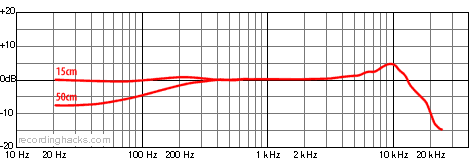 The frequency response chart for the Edwina confirms what I was hearing, showing them tapering almost linearly from 10kHz and down 10dB at 20k. Below that taper, though, there’s a slow rise that begins around 2kHz and rises more steeply from 5–10kHz giving the mics plenty of presence that is the right amount of bright without ever sounding harsh — “balanced” is the best way to describe them. When so many newer condensers tend to favor an exaggerated mid- and upper-mid range for impact, it’s nice to hear a “flattering-because-it’s-natural” tone from a microphone.
The frequency response chart for the Edwina confirms what I was hearing, showing them tapering almost linearly from 10kHz and down 10dB at 20k. Below that taper, though, there’s a slow rise that begins around 2kHz and rises more steeply from 5–10kHz giving the mics plenty of presence that is the right amount of bright without ever sounding harsh — “balanced” is the best way to describe them. When so many newer condensers tend to favor an exaggerated mid- and upper-mid range for impact, it’s nice to hear a “flattering-because-it’s-natural” tone from a microphone.
The mics stayed on my kit as overheads and were used to track Bend, OR band, Elliot, for their latest record when they came to Seattle for drum tracking; everyone was immediately happy with the drum sound, so there was no need to change the mics out.
Just after the Elliot sessions, Seattle-based nerd-rock band, Kirby Krackle came in to record a scrappy power-pop version of “Rudolph the Red-Nosed Reindeer” as a holiday giveaway to their fans. Once again, the Edwinas pulled overhead duty while we tracked drums and bass along with a scratch guitar and vocal.
With the rhythm-section parts tracked, we moved to guitars. I wanted to cut both guitarists’ rhythm parts simultaneously, so the Edwinas came down and each went in front of an amp paired with an 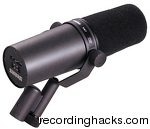 SM7B on one amp and a transformerless 57 on the other. The Edwinas were facing straight on each speaker, just off-center of the dust caps, and the dynamics were angled at 45° next to the Edwina capsules and further to the outside of their respective speakers. The tone was instantly what I was hoping for, with the Edwinas providing a full-range tone with plenty of low-mids for body and that smooth top-end that I liked so much on the cymbals, giving the guitars plenty of definition to cut through the largesse of the bass and drums. I blended the SM7 and 57 in for some extra mid punch, but they were only about 30% to the Edwina’s 70% of the final tone.
SM7B on one amp and a transformerless 57 on the other. The Edwinas were facing straight on each speaker, just off-center of the dust caps, and the dynamics were angled at 45° next to the Edwina capsules and further to the outside of their respective speakers. The tone was instantly what I was hoping for, with the Edwinas providing a full-range tone with plenty of low-mids for body and that smooth top-end that I liked so much on the cymbals, giving the guitars plenty of definition to cut through the largesse of the bass and drums. I blended the SM7 and 57 in for some extra mid punch, but they were only about 30% to the Edwina’s 70% of the final tone.
With guitars done and sounding great, it was time for vocals. I’ve tracked Kirby Krackle’s vocalist, Kyle, on three records have always had to be particularly careful about mic choice and positioning because of a piercing sibilance that he produces. He’s also a very forceful singer and can easily overload a microphone. I set up the Edwina in front of him, patched the mic to one of my ClassicAPI VP26 preamps and a Daking FET II compressor, quickly got a level with him 6 inches from the grille, and went for it. Perfect. The mic choice was a keeper and two takes later we had the lead vocal.
Two-and-a-half hours after the first downbeat, the song was fully tracked and mixed and the Edwinas were a large part of the sound. Hear the track: Kirby Krackle – Rudolph the Red-Nosed Reindeer.
To sum up, I am a fan of these microphones. They sound different than any other mic in my collection, and I’m quite taken by their aesthetic. Ear Trumpet Labs has a growing stable of microphone designs, and Philip will also do custom work if there’s something particular you need that they don’t currently offer (I’ve spoken with him about he possibility of a stereo M/S mic, for instance).
Check out the Edwina and Josephine, or the rest of the Ear Trumpet Labs microphones.
matthew mcglynn
For the record, a “Bricoleur” is “a person who engages in bricolage.”
Now you know. 🙂
You should also know that Mr. Graham has generously offered an Edwina microphone to one lucky subscriber of the MIC NEWS newsletter. The winner’s name will be drawn at random in mid- to late April. If you’re already subscribed to my monthly ramblings, you’re already entered for the Edwina giveaway… if not, head on over to the newsletter signup form where you might win a microphone and you’re sure to win one email a month full of cranky pro-audio news bites from yours truly.
Posted in Microphones, Reviews | 1 Comment »
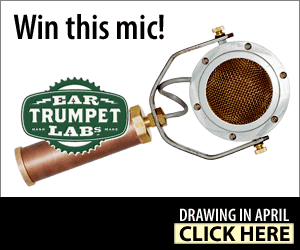
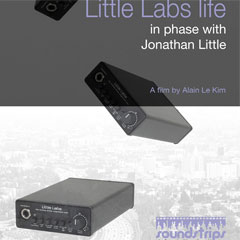

Edward Daley
March 10th, 2015 at 7:18 am
Love the look of these microphones. Makes me want to record something,anything right now !